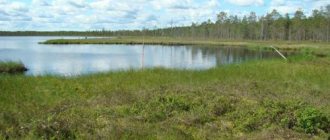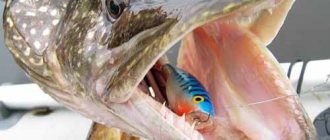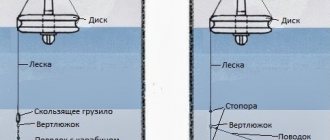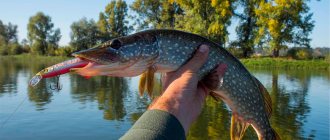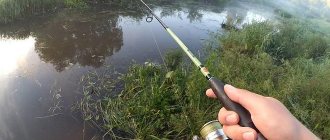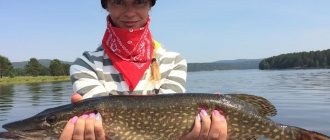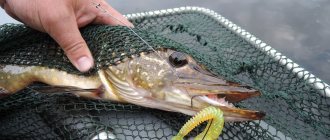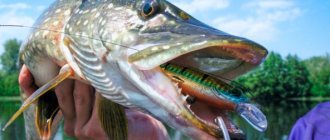In early spring, pike begin to be caught using spinning rods from the shore and boats. This article outlines tips and recommendations for choosing bait, as well as searching for pike in a pond in the spring.
Within the framework of this article, we will analyze in detail the spinning method of fishing , although pike can also be caught with circles and on a track. Less often - on a donk or a regular float rod.
The best time to hunt pike is spring. At this time she bites throughout the day. 10-12 days after spawning ends, the pike tries to stay in deeper waters. It becomes too weak and therefore, as a rule, is not caught on a spinning rod. However, later the spring 2-3 week long feeding season comes, and catching a pike will not be difficult with any gear.
Peculiarities of biting in March
In March, pike are much better than in April and May. These days, it actively feeds after winter stagnation, regardless of whether the ice has melted from the reservoir or not. You can use a variety of baits for catching pike in March.
A wonderful video about pike fishing in early spring:
When fishing for pike in March, there is no need to experiment. At this time, the pike is actively biting, but at the same time, the weather is still too cold. Despite this, winter gear should not be used. A bottom fishing rod will also not work. The best option is spinning fishing. In this case, artificial bait should be used.
Tackle and equipment
Motorboat. A relatively large boat, which is convenient for standing fishing with two or three people. You can, of course, simplify the task and get by with simple Soviet “Nyrk” or “Ufimka”, but once you try a normal boat, there is no turning back... A motor is simply necessary to move against the current, since you often pass a large section of the river, and the ascent against the current is oaring is a more than dubious pleasure.
In the boat, it is advisable to have a spacious landing net, a good anchor for the current, a release with a strong rope and a container for fish or kukan.
Coil. In principle, all that is required from a spinning reel is a good laying of the cord; it is desirable that, when closing the bail, you can only think about the wiring of the wobbler, and not about whether the cord lays on the side or not. Why is it important? Very often we cast a wobbler under overhanging bushes and immediately after splashing down the wobbler we begin retrieving. Delay or hesitation with the coil simply spoils the wiring, the “sweetest” part of the wiring disappears or, even worse, it gets caught in snags or bushes. You have to swim up, make noise and scare the fish under the shore. I use Daiwa Tierra 3000 or Banax Herse 750 most of the time.
Spinning. Everything is easier and more democratic here. You don’t need a phenomenally long cast, you don’t need super power for forced fishing in cramped conditions, you don’t need versatility, because you can have two or three equipped spinning rods in a boat. When I take two spinning rods into a boat, then, most likely, the first one is for twitching medium wobblers and light jigging in oxbow lakes and quiet waters, the second spinning rod is for twitching relatively large wobblers.
As the first spinning rod, which has already become an extension of my hand - Megabass Destroyer Blizzard Bull Barrel 712 with a dough of 4-16 g. Why him? Yes, the spinning rod is not really for twitching, rather a jig, but, firstly, this does not prevent it from easily and efficiently coping with twitching wobblers. And, secondly, sometimes instead of a wobbler on the cord there is a light jig for catching perch or a spinner, but more on that later... As the main spinning rod - Megabass Destroyer Manipulator 702 with a dough of 7-24 g. This is precisely what ensures long-range and accurate casting and excellent twitching of wobblers from ZipBaits Rigge 70 to OSP Rudra 130. It is this range of wobblers that I use most often. In the second case, the length of 7 feet is critical, because by noon you will become so stressed with a longer spinning rod that your arm hurts. Of course, other spinning rods are also applicable; at one time I was very successful in catching a Banax Spurt with a cast of up to 25 gr and a length of 7 feet. But one of my favorites, Banax Thunder 8'6 up to 25 g, had to be put aside, despite the fact that it does an excellent job of twitching wobblers, the hand gets very tired. But I don’t hide it too far; there is also fishing with jigs in holes and edges.
Cord. The most common one is YGK PE Super 0.21. Why such a large diameter? Because snags on snags and bushes are not uncommon, the current is quite strong, it is not easy to approach with a release and it is better to be safe from losing wobblers.
Wobblers. Now we have reached the most interesting part. Minnow wobblers with a depth from 80 cm to 1.5 meters. To say that choosing a wobbler is a purely individual matter is to say nothing. Here everyone has the right to choose, but I will describe my favorites a little lower.
How to equip a spinning rod for pike
If you are going to catch pike with a spinning rod, you should choose the right gear. The spinning rod should be 2.5-4 meters long. It is desirable that it has a soft tip. It makes it easier to control the bait. For standard fishing with a medium-sized jig, you can use a spinning rod with 5-25 or 10-30 gr. Smaller or larger tests are suitable for specific baits and more experienced fishermen.
Catching pike with a retractable leash is an equipment often used for jig fishing.
Which spinning rod is the best?
It is advisable to purchase a spinning rod from well-known, trusted manufacturers. Such products are more expensive, but they naturally have a different level of quality. This spinning rod is very durable and can serve for many years. If you can't afford such a purchase, take the middle class. In general, the differences in fishing will be insignificant.
Coil
The spinning reel is selected depending on the fishing conditions.
You should not buy a baitcasting reel, as you will get tired of untangling beards - this is not an option at all for catching a toothy predator. A medium-sized spinning reel is perfect for pike fishing. It is also advisable to take care of a spare bobbin.
fishing line
It is important that the line goes without any problems, easily and simply. The reel should be wound with monofilament, the thickness of which should be approximately 0.25 mm - this is the optimal size for pike. Thicker lines can spook fish, and thin lines aren't as strong.
When fishing with spinning rods, anglers are increasingly giving preference to braided fishing line - it is more reliable. The disadvantage of such a fishing line is its price, as well as some physical features that can lead to cuts if handled carelessly during wiring.
Lures
In March, pike can be caught using a variety of baits (jigs, spinners, wobblers). This is the period when there is a lot of caviar in the belly of the predator, so large baits do not attract it. If the size of the bait is more than 5 cm, the pike simply will not be able to swallow it. For fishing in the second half of spring, when spawning has not yet passed, you should take the smallest baits.
The video below shows spinning lures used to catch large pike .
Choosing lures for pike fishing with a spinning rod is a wonderful detailed guide to choosing bait.
If you are a beginner, then stock up on a standard set of baits, among which you will have something to use when fishing and evaluate the catchability of the equipment and its attractiveness to a predator:
- Three rotating spinners.
- Three oscillating spoons.
- Five medium twisters with 10-15 gram jig heads.
- Five silicone vibrating tails.
Through experimentation, you should choose the size and color of the bait. Pike can behave unpredictably in different conditions, so you need to act according to the circumstances.
☸ Bottle fishing
In this unusual gear, a plastic bottle performs two functions at once: a float and a device designed to hook a predator on its own. That is why small containers up to 1.5 liters will be ineffective due to low resistance and less visibility in thick grass. You can’t go to the other extreme either. Of course, a 5-liter bottle will hold a predator and it will be hooked, but where is the guarantee that such a huge and incomprehensible object will not scare away all the fish within a radius of several tens of meters?
As for the equipment, it consists only of a fishing line and a hook. You will also need a rubber band to secure the amount of thread remaining on the bottle. Whether to use a leash or to catch without it is up to each “bottle catcher” to decide for himself. Some craftsmen will improve the tackle with a bright signal flag, but by and large this is an extra element. When a pike grabs a live bait, the float bottle begins to play in such a way that only a blind person would not notice it.
Some people call this fishing pampering, others poaching, and for some it has become a favorite pastime. Objectively speaking, this is just one of the variations of the long-known fishing with girders. Both the principle of operation and their disadvantages are absolutely the same. Nevertheless, catching pike with a bottle has found its admirers. They are not stopped either by the wind, which drives all the arranged gear to one shore, or by the total volume of containers that occupy the entire trunk of a car.
The best lures for pike
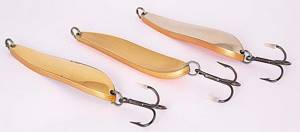
Spoons
, an oscillating spoon is best suited . For deep predators, you should take a heavy spoon. When spawning takes place, use bait that is small in both weight and size so that it can be retrieved in shallow water. At this time, the pike becomes lethargic and weak, so it does not chase prey.
Wobblers
Anything can happen while fishing. Pike may absolutely not go to the oscillating spoon. Many fishermen use a wobbler in such a situation. The best wobbler for pike is Minnow (extended wobbler). The most suitable option for spring pike hunting is a suspender, since it can harden in water. Even a well-fed predator will not be able to resist such bait.
Spinnerbait
Spinnerbaits are one of the varieties of non-hook baits that allow you to catch pike in any thicket. They are able to lure out even the most cautious pikes and do not cling to anything even in dense vegetation. If the reservoir is really thick in terms of algae, a spinnerbait is a good option.
Jig (twisters and vibrotails)
Excellent results when fishing for deep-sea pike can be obtained by using a traditional jig weighing up to 10 grams. You should also carefully decide on the size of the bait. A small fish will not notice, but a large one may scare it away. The best size is 6-8 cm. To make the bait more attractive, use twisters and colorful vibrotails. Experienced fishermen believe that this bait is the best for spring jig fishing.
Fishing with live bait
Pike loves live bait - this is a fact, but when fishing with a spinning rod, live bait is rarely used. pike is the rule. Below is a picture of how a live bait is attached to a fairly large hook.
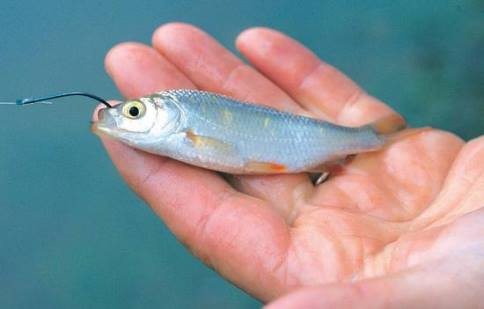
The larger the bait, the more pike you will catch.
How to catch pike
A variety of techniques allow production to be carried out in almost any conditions on water bodies. Regardless of the strength of the wind and precipitation, roughness on the surface, the presence of open or ice-covered water, as well as the depth and size of the reservoir or the structural features of its bottom, the fisherman has the opportunity to plan fishing based on the choice of his method. The well-known techniques themselves can be divided into two branches: fishing for pike from the shore and the need to use them for installing and monitoring the installation of a swimming device. For some methods, you will need a fishing rod, with the help of which the rigs are fed into the hunting zone and the trophy is fished out.
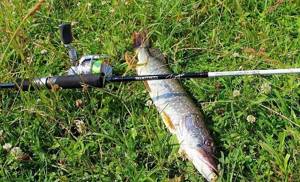
Fishing using rods is divided into two methods:
- spinning;
- float
To carry out hunting in other ways, devices are used, the combined structures of which are at the same time storage of fishing lines and bite alarms. These areas include floating circles, zherlitsy, winter rates, better known as flags, and kolybakhas. Bottom fishing is carried out using a classic donka, the basis of which is a cord with leashes. Its modification with an elastic band contributes to greater fishing comfort and less noise from the fisherman’s activities in the fishing zones. We will consider the basic methods of catching trophies in more detail, emphasizing the important nuances of technology and equipment of fishing devices.
Spinning fishing
Spinning fishing is one of the youngest and most progressive types of catfish hunting. A specialized fishing rod, called a spinning rod, is equipped with a reel with a main cord to which the bait is tied. For the most part, the spinning method of hunting uses artificial bait in the form of various modifications of spinners, wobblers and silicone fish.
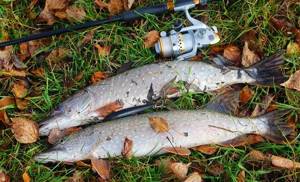
The selection of a spinning rod can be made according to its various performance characteristics, which are influenced by the bait used for hunting, and in particular, its weight and the principle of animation, the depth of the reservoir and the place where the bait is supplied, because for boats it is more convenient to use short forms. The technique of fishing for pike with a selected bait also differs in its method of execution. Twitching, jigging, casting, and trolling methods of presenting bait are fundamental technologies in spinning fishing. Each technique has certain styles of bait, depending on the conditions prevailing during the extraction of the trophy. You can use a spinning rod to catch pike from the shore and from a boat.
Important! In particular, trolling or trolling is only possible from a swimming device.
The very principle of spinning fishing is based on casting bait using a rod and then moving the simulator at different speeds and along different trajectories. The species is dynamic and requires the angler to constantly move, forcing him to look for pike on a river or lake. Spinning is used by anglers during the open water season, from early spring until late autumn. Spinning fishing for pike in troubled waters is very productive. By manipulating bright baits with noise chambers, spinning baits provoke even passive fish in conditions of reduced visibility of spring polluted and melt water.
Live bait fishing rod
Quite a dynamic and interesting way of catching catfish. To a greater extent, its effectiveness is manifested for catching pike on a small river, with a high intensity of overgrowing of the riverbed with underwater and floating vegetation. The summer season is the most favorable time to use this fishing method. Live baits of small fish are used as bait, which are caught directly at the pike fishing site. The basis is a telescopic fishing rod, the size of which allows the fisherman to cast the rig into openings and windows free of vegetation. Live bait is placed in the middle water horizon for five to seven minutes.
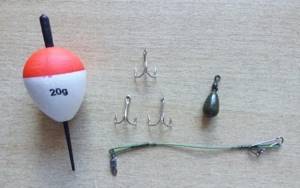
If there is no bite during this period of time, the angler moves to another promising place, periodically returning to the old points. They try to make summer rigs more subtle, since the finicky and capricious predator is suspicious of negligence in summer rigs. The float is immersed up to the antenna so that when biting the fish does not feel its weight or resistance at all. Fluorocarbon leaders that are invisible in the water will increase the likelihood of an attack. Single hooks are used, with a long shank, no higher than number eight.
Fishing with mugs
Mugs are hunted using a swimming device.
Important! For fishing, there are two main strategies: when mugs are placed in backwaters with standing water in thickets, and when devices are launched with the flow or with the help of the wind over promising pike anchorage points.
The circle itself consists of a foam or wooden reel and a rod, with the help of which the equipment is installed and the bite is recorded. The method is ideal for catching pike on a lake where there are both clean and promising water areas overgrown with aquatic vegetation. Live bait is caught locally and mounted on double hooks, placed at half-water or forty centimeters from the bottom, subsequently unifying all gear to the horizon in which bites occur more often. The installed gear is constantly monitored, tracking possible bites. They swim up to the created circle carefully, trying not to frighten the fish that took the bait. They collect the loose cord that has been wound out into the boat, and when they feel the heaviness, they make a hook and begin to fish for the caught trophy. Having brought it to the boat, the fish is taken into the landing net and placed on the kukan, lowering it over the side of the boat. Pike are caught in circles throughout the open water season, but the time of autumn catfish feeding is considered the most successful time for hunting.
Zherlitsa
Zherlitsa is the most ancient method of hunting pike. Anglers use similar bait fishing techniques for summer and winter conditions. In open water, using a jig is convenient for catching pike in the grass near the shorelines. The tackle is a reel, mostly a wooden flyer, on which the assembly is wound. The flyer is put into working position by lowering the live bait into the water on a fishing line and attaching the flyer to a natural object in the form of a branch of a bush or tree, a bunch of reeds or reeds above the water. If there is no fastener, install it on the bank of a pole or pole. A piece of fishing line on which the live bait is mounted is clamped into the slot of the flyer.
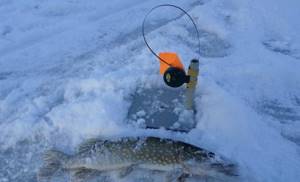
When a pike grips, the force of the blow causes the line to fall out of the slot and drop freely into the water. The fish, suspecting nothing, swallows the bait and kills itself. The fisherman determines the bite by the cord unrolled into the water. The winter bet or flag bet works on a similar principle. Only instead of a flyer they use an inertial reel, and the bite indicator is a bright flag thrown out when the fishing line is pulled from the reel. Winter pike hunting with flags is rightfully considered one of the most spectacular ways of catching catfish. Classic girders are effective in the summer and especially on overgrown reservoirs. Flag rates apply throughout the freeze-up period.
Wiring and technology
Aggressive wiring
Spinning fishing is almost the same in May as in early spring. But for this you need to find a good place. Throw the tackle and start making a quick reel, but without acceleration. If you cast your bait in shallow water, your chances of catching a fish will increase significantly. A stepped or slow approach in May does not give much effect, because if the pike is found in this place, it will grab the prey in any case.
If you're lucky and the pike takes the bait, it's time to hook it. Before spawning, the pike will not resist much, so you can easily get it out of the water. There are even predators that do not make any jerks when they are taken out of the water. They are easy to bring to shore. Despite the fact that pike is considered a solitary predator, if you catch a fish, try casting the tackle with bait again to the same place. Either way, you'll catch another fish with a belly full of eggs.
☸ Fishing with live bait on a spinning rod
The combination of spinning tackle and live fish is a powerful weapon against the main predator of our latitudes. If neither expensive fancy wobblers, nor edible rubber, nor spinnerbaits of the most incredible designs seduce the pike, one small crucian carp or perch can change the situation. Therefore, in the summer, catching pike with a spinning rod using live bait is very important.
There is no need to alter or adjust the gear for this type of fishing. It is only worth mentioning that in currents it is better to use braided line as the main line, and in still water it is better to use monofilament. A special leash is used that is not afraid of pike teeth (titanium, Kevlar, braided cable, guitar string). It is advisable to choose a hook with a short shank or install a tee.
In this type of fishing, the smoothness of the retrieve plays an important role. The slower the fish goes, the greater the chances of a bite. Unfortunately, catching pike with live bait on a spinning rod has one significant drawback: small pike fish are constantly interested in the bait.

Fishing from a boat
To catch pike from a boat, you can use fishing devices that are suitable for fishing from the shore. Fishing from a boat is done by placing bait. This is a rather complicated process. For fishing in small bodies of water, small swimming devices should be used. If you find a school of white fish using your echo sounder, you can be sure that the catch will be large, since pike usually feed near such schools. You can also try fishing for pike in the bottom area, especially in places where there are a lot of irregularities. If there is little activity, you can try fishing with wobblers with rattles.
How to catch pike with mugs
Beginners who have never tried this method can use the simple useful tips outlined in the article about “The subtleties of catching pike with mugs.”
Blitz tips for fishing with mugs
In any case, if you want to catch pike with mugs, you should do this in closed reservoirs without running water or in the bay of a large river.
You can identify the mug's shortcomings after installation on the water.
When choosing a fishing line for a circle, you should remember that its length directly depends on the depth of the reservoir. If the depth is 3 meters, you will need 9 meters of fishing line, that is, three times more.
The mugs should be launched in a checkerboard pattern so that they cover a large area.
☸ Requirements for bait and methods of baiting
Summer pike fishing with live bait has its own characteristics. Firstly, not every small fish is suitable for these purposes. For example, a ruff would be a bad choice, even if you cut off all its spines. Practice has shown that the predator prefers to hunt those underwater inhabitants that live in the same body of water and are its usual food. Usually these are such common species as gudgeon, roach, bleak, crucian carp, silver bream, perch, rotan. It is important that the live bait lives up to its name, that is, it is lively and playful. A pike may simply not notice a sluggish, half-dead fish.
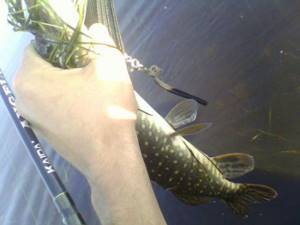
How to catch live bait? Most often, a small trap is used for this - a special square-shaped trap with a stretched fine mesh. They throw it in places where the fry gather, wait until they gather on top, and quickly pick them up. Bait helps speed up the process.
If time permits, live bait can be caught with a regular fishing rod. Of course, you can’t prepare a lot of small change this way, but it’s not necessary. The fewer fish in the bucket, the livelier they will be.
Live bait is baited in different ways, it all depends on the size and shape of the hook. The most common techniques: under the dorsal fin, behind the abdomen, through the gills or nostril. The main thing is that it is not seriously injured, remains mobile and stays securely on the hook.
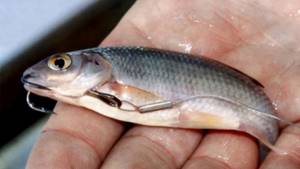
Key points in spring pike fishing
It should be remembered that the most important point in spring pike fishing is finding a promising place. If you can find the predator, half the battle is done. The choice of bait largely depends on the fishing conditions. Experienced fishermen do this without difficulty, but beginners should work hard to determine which bait is best suited for a particular place - there is no universal bait for all occasions, there is nothing you can do about it.
With these simple tips, your catch should increase significantly, making you love spring pike fishing with all your heart. Good luck to you, friends!
